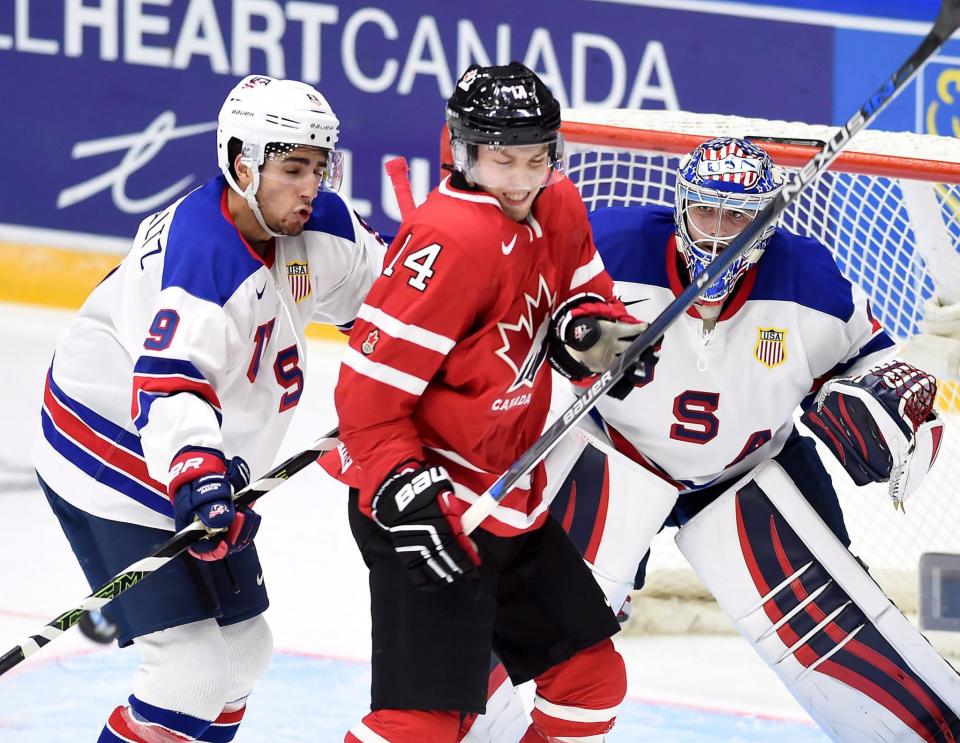3 storylines for Canada-USA showdown on New Year's Eve

The 1972 Summit Series cemented Canada’s rivalry with Russia for all eternity. Since then there have been many games – Olympics, world championships and world juniors – that have only added to the lore.
The only rivals that might come close – at least from the WJC perspective – is Canada vs. the U.S., which over the years has become a traditional New Year’s Eve mainstay.
Historically, Canada has dominated the U.S. in head-to-head battles since 1977, but more recently, the U.S. drawn much closer. Their last meeting, at the 2016 tournament in Helsinki, was a 4-2 victory for the eventual bronze medalists from America.
Canada and the U.S. will meet again on Saturday to decide the winner of Group B and close out the round-robin portion of the tournament in Toronto, before it moves to Montreal for the medal rounds. Here are a few things to keep an eye on when these two teams meet.
Special Teams
Prior to facing Latvia on Thursday night, Canada’s power play was clicking at a ridiculous 55.5 percent. Consider the penalty problems the U.S. had against Latvia – which included three straight slashing calls – in their tournament opener, the Americans can’t afford to sit in the box against Canada. The U.S. fared much better against Slovakia in its second game of the tournament, playing with pace and discipline (they only took two penalties).
Having said that, the U.S. is going to have work on its penalty kill. Their PK was lackluster against Slovakia, allowing the Slovaks to score on their second power-play opportunity. Obviously, cutting down the penalties in general is going to be a huge help, but against Canada even one or two could end up being the difference in the game the way Canada is clicking.
Historically, games between Canada and the U.S. have been physical affairs so the chance for penalties (especially under IIHF officiating) is high.
Game Breakers
As the tournament progresses so does the line tweaking. The U.S. made some changes in advance of their game against Slovakia which seemed to work, while Canada has had to make some adjustments moving Mike McLeod – the 13th forward – onto the top line to start against Latvia with winger Mitchell Stephens sidelined by a lower body injury.
For Canada, however, the key is going to be captain Dylan Strome – not necessarily from a goal scoring perspective – but in terms of setting the pace. Strome was banged up in Thursday night’s game against Latvia, but it’s not serious. Canada has done a good job of using their defenders to generate offence, so the top tandem of Thomas Chabot and Philippe Myers should be busy against the U.S. Winger Tyson Jost and centre Mathew Barzal are guys the U.S. has to keep in check. Coming off a four-goal game against Latvia, Erie Otters star Taylor Raddysh, the leading scorer in the OHL, looks like he’s found his form.
Tyson Jost gets Team Canada's first goal of the 2017 #WorldJuniors! @CanadianTire #BigPlay https://t.co/JLvAqi0ZFz pic.twitter.com/buq1ItItUb
— TSN (@TSN_Sports) December 27, 2016
At 6-foot-5 and 200-pounds Tage Thompson, a first-round pick of the St. Louis Blues, is a one-man wrecking crew for the Americans. The scariest thing about Thompson isn’t his size though, it’s his deft hands and his agility as a big man. Canada can’t afford to let Thompson push his way to the front of the net.
Tage Thompson scores the goal of the game to put the Americans up by two. @CanadianTire #BigPlay #WorldJuniors https://t.co/JLvAqi0ZFz pic.twitter.com/qlpTVryalO
— TSN (@TSN_Sports) December 29, 2016
Offensively, the other threats Canada has to contain are Clayton Keller, Colin White and Jeremy Bracco. Bracco – one of the top offensive threats in the OHL for Kitchener – has had a relatively pedestrian tournament, so he’s due for a big game.
Goaltending
Nothing gets the hand-wringing from Canadian fans quite like the issue of goaltending at the world junior tournament. With both Carter Hart and Connor Ingram getting starts in the tournament, no matter who head coach Dominique Ducharme goes with against the U.S., they’re going to have to make the big saves (and over the last few years those have been hard to come by for Team Canada, sorry Mark Visentin).
UPDATE: Coach Ducharme announced Saturday morning that Connor Ingram, who shutout Slovakia earlier in the week, will draw the marquee U.S. matchup.
Tyler Parsons seems to be the favourite to start against Canada after drawing the assignment against Russia. Joe Woll played quite well against the Slovaks, so if Parsons gets into trouble he’s a nice Plan B for the Americans.

 Yahoo Sports
Yahoo Sports 

